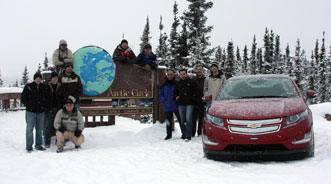GM Touts Chevy Volt’s Winter Driving Capabilities, Expands Previous Truck Recall

Winter’s cold still might grip most of the country, but General Motors reassured dealers and owners that the first Chevrolet Volts “came fully winterized.”
Turns out, the first retail customers who took delivery of those extended-range electric vehicles reside in New Jersey. The transactions also occurred just as the season’s first major blast of winter weather arrived.
GM reiterated that one of the goals in developing the Volt was to create a plug-in electric vehicle suitable for everyday use regardless of weather. The company conceded typical northern winters take an even bigger toll on battery-powered vehicles than on traditional internal combustion-powered cars and trucks.
The automaker believes that engines produce plenty of waste heat that can be used to warm the air in the cabin and keep things comfortable. Officials also contend the inherently greater efficiency of an electric powertrain means less wasted energy, but it also means that the battery has to be used to power a resistive heater to produce that warm air — electrical energy could otherwise be used to propel the vehicle, which is one of the reasons why electric vehicles can have a significantly shorter driving range in cold weather.
“It requires as much energy to heat the interior of a car on a cold day as it does to drive at a constant speed,” explained Susan Stevenson, General Motors benchmarking engineer for heating, ventilation and air conditioning systems.
As a result, GM mentioned the Volt has several features designed to minimize the drain on the lithium ion battery while still affording occupant comfort. The exclusive OnStar MyLink smartphone app or the MyVolt.com website can remotely start the Volt and warm the cabin while it is still plugged in and drawing power from the grid, leaving the battery with a full charge to maximize the electric driving range.
“The coldest weather I’ve experienced so far with my Volt was 18 degrees during a drive to the Poconos and I’ve had no complaints,” noted Jeffrey Kaffee, the first retail customer to take delivery of a Volt in mid-December.
“Most of the time I just use the Eco mode instead of the comfort mode and it’s been no trouble whatsoever,” Kaffee added.
Less energy is consumed maintaining the cabin temperature than heating it up, according to GM. But even on the road, the OEM insists the Volt has more to contribute. Heated seats available on the Volt require less energy to keep passengers warm and comfy than it does to heat the full volume of air in the car.
Furthermore, the manufacturer said the Volt also can use the engine to generate some extra heat and electrical energy in sub-freezing temperatures. In sub-freezing temperatures, the engine can periodically cycle on and off, heating the coolant to create a reservoir of thermal energy that is then used to warm the cabin air.
GM asserts that using engine heat this way enables faster window defrosting and rear seat heating than taking energy from the battery. Under light driving loads, the engine and generator also can put some electrical energy back into the battery during these heating cycles to extend the electric driving range.
“Volt drivers in southern California will likely never experience this in their day-to-day commute, but if they pack up their gear and head into the mountains for some skiing, they will appreciate the enhanced cabin comfort made possible by this unique powertrain” stated Andrew Farah, vehicle chief engineer for the Volt.
Even with all of the energy optimizations, GM stresses the same mechanical factors that lower fuel mileage for traditional vehicles contribute to a shorter electric driving range in winter. Cold temperatures can increase the viscosity and resistance of lubricants in transmissions and axles, while roads covered in snow or slush can increase rolling resistance causing the powertrain to work harder and drain the battery.
But the Volt’s engine generator dramatically can reduce the fear of being stranded. When the lithium ion battery is depleted, GM explained the extended range capability can allow the unit to continue on for up to 340 additional miles.
“Volt engineers spent many frigid weeks in places like Kapuskasing, Ontario, and Fairbanks, Alaska, testing and calibrating the climate control system to make sure that drivers and passengers remain comfortable while still enjoying plenty of gasoline-free electric driving even in the harshest winter weather,” Farah highlighted.
GM Broadens Recall for Axle Cross Pin in Certain Trucks
In other company news, GM revealed this past weekend that it is expanding a recall of certain 2011 model-year trucks to include additional full-size trucks and midsize pickups to replace the rear axle cross pin. The part may have been improperly heat-treated and could fracture, causing the axle to lock while driving.
The automaker stated the original recall that occurred last month of 1,262 U.S. vehicles now includes 26,751 Cadillac Escalade, Escalade ESV, Cadillac EXT, Chevrolet Avalanche, Colorado, Silverado, Suburban, Tahoe; and GMC Canyon, Sierra, Yukon and Yukon XL.
GM said owners of the vehicles are being contacted and urged against driving the trucks until the axle pin is replaced.
“If the pin fractures and becomes displaced within the rear axle, the driver may hear a banging noise coming from the axle,” GM officials explained. “If the pin shifts out of position, it could create an interference condition and cause the rear axle to lock. The driver may not be able to maintain directional control of the vehicle, which could lead to a crash.”
The OEM emphasized that it knows of only one customer incident in which a driver experienced a loss of power to the axle but there was no crash. GM added that it’s unaware of any crashes or injuries related to the condition.

 View The Latest Edition
View The Latest Edition

